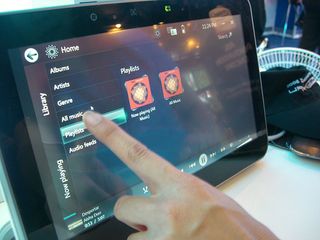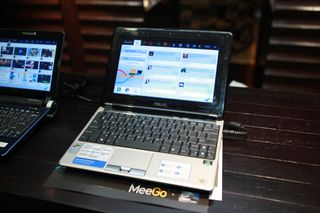Tom's Talks Moorestown With The Father Of Centrino
With its new Atom platform, Moorestown, Intel has made a lot of exciting claims and hinted at significant changes in our computing future. All good stuff, but we need more answers. To find them, we sat down with Intel’s godfather of ultra-mobility.
Moorestown Tomorrow
TH: Where do we need to go next? I mean, from everything you’re describing and I’ve seen, it seems like we’re “there,” with all of the performance and power anyone could need. So what do we do next?
TT: For a handheld device, there are two things that are always going to be very pertinent. The first is how small you can make the device. Can we make it smaller than an iPhone? The second thing is going to be whether you can make it even higher power. Batteries increase in capacity by about 7% to 10%—10 % is an outlier, so really 7%—year to year in terms of density. Some of the bigger phones are going to have instead of 1,000 mAh, maybe 1,500 mAh batteries. So the pressure to get power lower is always going to be there. Also, I’d add a third challenge: how can we continue to drive higher capabilities and functionality in this class of device? We’re going to continue to push on those three angles as hard as possible.

TH: We’ve already profiled how Atom has evolved from its first appearance to Linfield. How do you see that evolution continuing in the future?
TT: Obviously, we will continue the architecture. We clearly want to go push the CPU performance higher, but getting higher performance at lower power is going to probably be the biggest thing we’re going to focus on. But also remember our 2x performance increase in graphics, the addition of full HD video recording, and dual-camera capabilities. If you look at those trends, it’s going to be very important to make sure that they continue.
TH: Speaking of graphics, Intel obviously has not yet made a name for itself in performance graphics. Now, we’re suddenly talking about powerful graphics and video from an integrated Intel chip, which is essentially an oxymoron in the desktop world. So can you tell us more about exactly how Intel is ramping up this graphics capability and doing this acceleration?

TT: We’ve added graphics capability that includes both vertex and floating point, as well as the rendering capabilities increasing. But you have to really look at system-level performance. The key thing there is whether we provide enough bandwidth capability to the graphics accelerator. Because if you don’t, most of these things will get choked right where you need the bandwidth. Balancing system throughput is key. Look at our memory subsystem and design internally. We put in a lot of energy in there to make sure we have a very effective bandwidth, not just for the CPU but also for the accelerator. Unfortunately, I can’t go into more details than that at this point.
TH: If these are the PCs of tomorrow...well, we’ve seen netbooks start to cannibalize notebooks. I’ve got to believe that these ultramobile devices, if they really are PC-like as you say, will take a pretty sizable chunk out of your existing mobile product base—only now at lower price points. Is that a problem or are you anticipating that volume is going to make up the lost ground?
Stay on the Cutting Edge
Join the experts who read Tom's Hardware for the inside track on enthusiast PC tech news — and have for over 25 years. We'll send breaking news and in-depth reviews of CPUs, GPUs, AI, maker hardware and more straight to your inbox.

TT: If that were the case, yes, it would be a problem. But that is not the case. Netbooks have not cannibalized notebooks.* They have added to top line and bottom line growth for us. If I go to the phone space, we don’t play there today, right? With Moorestown and Medfield and beyond, the intent is to become a player in this space because these devices are coming to where Intel is strong. So, I don’t buy the premise of your question. This all growth for us.
* Ed.: Apparently, prior sales analyses are open to interpretation. See http://www.reuters.com/article/idINB97620320090527?rpc=44.
-
whitecrowro "Why are we all here today? What is the meaning of Moorestown?Reply
Ticky Thakkar: Our vision was to.."
- pardon me, but all this naming sound like a Star Trek interview, on Tau Cygna (M class planet in Orion Nebula). -
cmcghee358 It would be nice to see Intel take a jab at discrete desktop graphics. If anything just to provide more competition for the consumer.Reply -
liquidsnake718 It would be nice to see that Zune HD ver 2.0 or even 3.0 with an updated Moorestown and a better Nvidia chip than the ion or ion2, with capabilities of at least 2.0ghz and 2gb of ram all the size of the zune.... imagine with 48hours on music, and 5 hours of video, this will only get larger as time goes by.... hopefully in a year or a year and a half we can see some TRUE iphone competition now with the new windows mobile out! We just need more appsReply -
Onus It never occurred to me to want an iPhone, but I definitely see one of these in my future.Reply -
matt314 cmcghee358It would be nice to see Intel take a jab at discrete desktop graphics. If anything just to provide more competition for the consumer....discrete desktop graphics is a pretty niche market. Without any experience in the field or specialized engineers, it would cost them alot of money in R&D, and they would not be able to beat ATI or nVidia (neither in performance nor sales)Reply -
cknobman Maybe its just me but I read the entire thing and Mr. Shreekant (Ticky) Thakkar came off as a arrogant ********.Reply -
Onus cknobmanMaybe its just me but I read the entire thing and Mr. Shreekant (Ticky) Thakkar came off as a arrogant dickhead.Merely disagreeing with you doesn't merit a "thumbs-down," but I didn't get that impression. Confidence, maybe; his experience no doubt backs that up, but I didn't find him arrogant. I liked how he called BS on the FUD.Reply
-
zodiacfml I read his comments carefully and found that those were carefully chosen words. Confidence is very much needed to get the support everyone while remaining factual.Reply
In summary, I expect their device to be better performing than anything else in the future at the expense of a huge and heavy battery to power the Atom and the Huge screen making use of excess performance.
cknobmanMaybe its just me but I read the entire thing and Mr. Shreekant (Ticky) Thakkar came off as a arrogant dickhead. -
cjl zodiacfmlI read his comments carefully and found that those were carefully chosen words. Confidence is very much needed to get the support everyone while remaining factual.In summary, I expect their device to be better performing than anything else in the future at the expense of a huge and heavy battery to power the Atom and the Huge screen making use of excess performance.Did you read the article? One of the points raised was that the battery life should be just fine, contrary to many people's assumptions.Reply -
eyemaster He knows his product, the targets to meet and what they have accomplished. I'm sure they experimented on competing devices too. The man knows that they have a great product in their hands right now that beats all the others. That makes him confident, not arrogant.Reply
Most Popular

